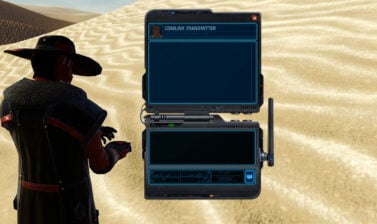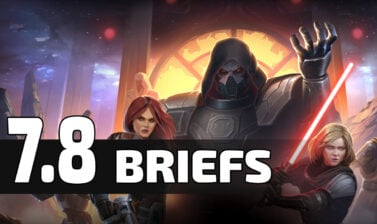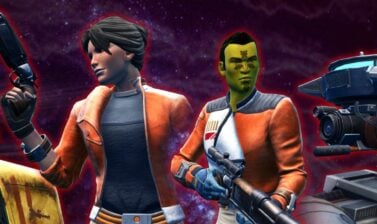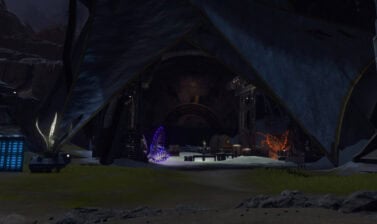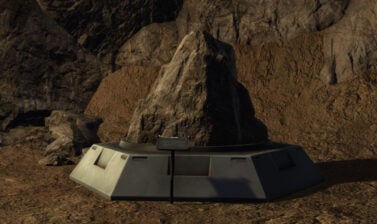SWTOR’s difficulty is fairly complicated and governed by a ton of different factors including enemy rank and immunity buffs, levels, special regions, difficulty settings for instances, gear, and companion influence.
Table of contents
Levels and Level Sync
Levels affect how much damage you can deal to the enemy and how much they deal to you. Enemies that are 5 levels above you are immune to your attacks, and you are immune to damage from enemies that are 5 levels below you, though the effect is progressive over those 5 levels.
Level Sync is a system that prevents you from being more than 4 levels above any enemy in the game so you can’t completely outlevel any content. Before this system was introduced with 4.0, higher level players could do things like effortlessly take on World Bosses on lower level planets alone.
Level Sync works by capping your stats to what you could get on gear balanced for that level, though it does not affect tertiary stats like Critical and Alacrity Rating.
For example, Hoth is designed for players between levels 37-41 and all enemies on the planet have levels within that range. If your level is 42 or higher, you’ll get level synced down to level 41 and your stats will reflect what you’d find at gear you could equip at level 41.
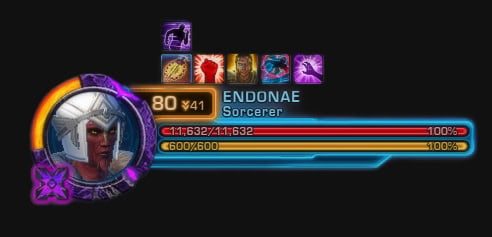
The Level Sync system can also be used to Bolster stats if they’re too low, which happens in Story Mode Operations, Warzones, and Arenas.
Check out our 7.0 Level Sync Changes Overview for more details.
Enemy Difficulty Ranks
Each enemy has a difficulty rank assigned to it. Difficulty ranks affect an enemy’s health, damage output, capabilities, and mechanical complexity with respect to the Instance’s difficulty mode and level.
Difficulty ranks represent an enemy’s stats and their skill. The higher the difficulty rank, the more rewards and XP you get for defeating them.
Standard
Standard is the most common enemy rank. The vast majority of enemies you’ll encounter in the open world are Standard enemies. They don’t deal much damage and typically only spam a single attack. Sometimes, they also have a casted ability.
Their health is balanced such that they can be defeated by singular high-damage rotational abilities. Solo Builds are designed to let you take out all Standard enemies in 2-3 GCDs using an AoE combo by enabling your heavy hitters to damage multiple nearby enemies.
You’ll typically find them in packs of 3-4 out in the open world. Standard enemies are also vulnerable to additional CC effects present on some attacks.
Weak
Weak enemies sometimes accompany Standard enemies. They’re typically smaller in size, deal practically no damage, and can’t survive any attack that’s primary function is to deal damage. Like Stanard enemies, they are also vulnerable to additional CC effects present on some attacks.
Weak enemies appear in a wide variety of configurations. Neutral (Yellow) noncombatants like droids and small creatures are typically Weak enemies. The 4th enemy in a group of Standards will sometimes also be a Weak enemy. Due to their inability to stay alive, they’re more often used as cannon fodder to make your character look more powerful.

Strong
Strong enemies have more HP, deal more damage, have multiple abilities, and occasionally apply CC. They have the same types of vulnerabilities as players, though their overall capabilities are beneath that.
In the open world, especially at higher levels, you’ll typically come across a group of enemies with 1 Strong and 1-3 Standard enemies, or as a patrolling duo of Strong enemies. In Heroic areas, Strong enemies replace Standard enemies in ubiquity.
If your solo build spreads your damage from primary target or otherwise requires setup, you want that primary target to be the Strong enemy. Standard and Weak enemies often don’t have enough HP to survive the entire combo.

Elite
Strong enemies have even more HP, deal even more damage, typically apply CC, and may have a rare or unique ability. They have the same types of vulnerabilities as players, and while they aren’t as capable as players, they are dangerous, especially when accompanied by other enemies.
In the open world, Elite enemies are typically alone or leading a patrol along with other Standard or Strong enemies. Before engaging, make sure you’re at full health, and use some of your offensive and defensive cooldowns when fighting an Elite enemy.
If your solo build spreads your damage from primary target or otherwise requires setup, you want that primary target to be the Elite enemy. Standard and Weak enemies often don’t have enough HP to survive the entire combo.
In Instanced group content, Elite enemies replace Strong enemies in ubiquity, and in Operations, they’re typically the easiest enemies you’ll encounter.

Champion (Bosses and Mini-Bosses)
Champions typically have a unique name, have multiple nonstandard casted abilities, deal more damage, and have an extreme amount of health. They are bosses and balanced to be your sole focus during an encounter.
They always have multiple casted abilities alongside basic attacks. In group content, these abilities become so complicated that we call them mechanics, which can’t always be managed by defensive cooldown (DCD) usage or CC alone and may require a coordinated response from multiple players.
There’s a pretty wide gap between Champion bosses in group content and mini-bosses in the open world, to the extent that the rank should be split in two.
Champions also have 10% Defense Chance against all attack types, not just Melee/Ranged damage. This is why you need 110% accuracy as a DPS and why tanks get +10% accuracy from their stance passive. Without it, your attacks would miss 10% of the time and your rotation would be ruined.
Along with a completely unique buff or two, Champions often have Boss Immunity, Robust, Unshakable, Steadfast, Overwhelming, and/or Terrifying, all of which make them immune to some of your CC abilities. We’ll go over what those mean in the next section.
Player
Yes, in this segment, we’re talking about PvP. You’ll only encounter enemy players in the PvP instance on planets and in Warzones and Arenas.
Players are vulnerable to all forms of CC, though every combat style has some way to become temporarily immune to at least 1 type. Some abilities affect players differently than NPCs, including Guard, Taunts, Electro Net, and, for practical purposes, Stealth Scans,.
Players have 5-10% defense chance depending on combat style, and that skews heavily towards 5%, so it’s recommended that you have 105% accuracy as a DPS in PvP unless the vast majority of your damage dealt is Force/Tech, in which case you don’t need any extra accuracy.
Common Enemy Buffs
Many enemies have buffs that protect them from some form of crowd control (CC), with the strongest enemies being completely immune to all CC.

Unshakable
“Casted and channeled abilites cannot be interrupted”
Unshakable grants immunity specifically to interrupt abilities. Every Combat Style has an interrupt ability; it has a cooldown ranging from 10-24s, with most being 12s or 18s. If you ever see an enemy with Unshakable but not Boss Immunity, you’ll probably need to stun the target to stop the cast or channel.

Boss Immunity
“Immune to incapacitating and movement-impairing effecs”
Boss Immunity makes the enemy immune to all forms of CC, save for interrupts. All bosses in group content have Boss Immunity, and most have Unshakable as well. If an enemy ever has Boss Immunity but not Unshakable, it almost always means you’re meant to interrupt something.

Steadfast
“Immune to physics and knockdowns”
Steadfast makes the enemy immune to knockbacks and getting knocked down, but not other types of CC. It’s effectively permanent Hydraulic Overrides | Hold the Line.

Robust
“Immune to incapacitating effects”
Robust makes the enemy immune to hard stuns and mezzes, so knockbacks and slows still work. It is a newer buff that, at the time of writing, only applies to some Champion enemies in Dynamic Encounters.

Overwhelming
“Hits from these massive beasts slow targets significantly”
Overwhelming makes the affected enemy apply a stacking slow debuff with its basic attack to targets it damages. You’ll find this on most large World Bosses and not much else.

Terrifying
“Only true heroes can fight this enemy”
Terrifying enemies make your Companion cower in fear as soon as you engage in combat. World Bosses are the only type of enemy with this buff, and the point is to make it so you have to group up to defeat them.
Some newer World Bosses like FR3-D0M and Kith’rawl, as well as the DvL bosses, are missing this buff, potentially enabling you to defeat them on your own.
Difficulty Modes and Instances
The difficulty of the game is broadly determined by your location. You see this most immediately with how different planets have enemies within a specified level range, but it applies to difficulty modes defined across the entire Instance. Each time you go through a loading screen, you’re being taken to a different Instance within the game.
Planetary Content and Enemy-Defined Difficulties
Planetary content difficulty is defined by region and the enemies therein. Different regions on most planets feature enemies that have different levels, and Heroic areas replace Standard and Weak enemies with Strongs and Elites.
Solo (Default)
Solo content is what you’ll find throughout the vast majority of the open world. Most enemies will be Standard or Weak, with higher-level planets sprinkling in some Strongs periodically. Elites are almost always alone in a more secluded area and a Champion exists in each large region.
Heroic 2+ (H2)
Heroic 2+ missions take place in Heroic areas and feature far more Strong and Elite enemies, potentially with some Champions here and there.
Heroic 4 (H4)
Heroic 4s are rare and consist almost exclusively of Strong and Elite enemies with a Champion boss at the end. They are effectively mini-Flashpoints.
Instance and Content Type-Defined Difficulties
All content that takes place within its own Instance comes in 2-3 difficulty modes. Like Phases, Instances are special locations with conditionally restricted access. While Phases exist as secluded areas of the open world, Instances require you to undergo a loading screen.
Story Mode (SM)
Story Mode almost never requires a full group to complete and might be designed to be completed alone. Story Mode is on par with Heroic 2+ missions, though the bosses are far more elaborate.
Veteran Mode (VM)
Veteran Mode is more demanding than Story Mode but can be done without a full group. Veteran Mode is on par with Heroic 4 missions, and the bosses can be more complicated.
Master Mode (MM)
Master Mode is the highest difficulty for a given type of content, though Master Mode for one type of content is not comparable to that of another.
Balancing Philosophy
Many players believe that [Heroic 2+] means that the content is required or intended to be done in a group by 2 or more people and think [Heroic 4] means it’s balanced for 4 players, but this interpretation leaves out key variables that muddy the waters.
These variables include maximum spec potential and balance targets, which we can express through proportionality.
Maximum Potential and Balance Targets
A given combat style and discipline has maximum potential output constrained by cooldown durations and stats, but those are skill ceilings, and not everyone will reach them.
Harder content demands that each player be closer to reaching the maximum potential of their spec and have a stronger understanding of how the game works. Gear and Companion Influence can only help so much.
Different difficulty levels allow Broadsword to balance around different proficiency requirements, but unless you’re demanding mastery (100% proficiency) from the entire group, it’s possible to complete the content with fewer players.
For example, the maximum potential of most DPS specs in 7.6 is ~34k DPS (±8%) with 344 gear. If you have 100% proficiency, you can do 34k DPS. If you have 75% proficiency, you can do 25.5k DPS. If you have 50% proficiency, you can do 17k DPS.
The only difficulty in PvE content in the game that comes close to requiring 100% proficiency from everyone is Master Mode (Nightmare/NiM) Operations. Most are still balanced around 85% proficiency because they can be undermanned (completed with fewer than 8 players).
Of course, undermanning requires each player to be more proficient than the balance target demands, so if a given NiM boss fight is truly balanced to require 85% proficiency, it can also be done by 7 players who are ~100% proficient. This wiggle room is what makes sale runs possible.
Math (click to reveal)
100% potential is the maximum possible contribution per player
100% max potential-85% required potential=15% leftover potential per player
15% leftover*7 players=105% of required output
Some of you might be wondering why the hardest content in the game is only balanced to require 85% proficiency. The answer is because this is a game and we’re human.
- Not many people like or can put in 100% effort all the time.
- Player skill is only half of the equation. Boss mechanics are the other half.
- Operations require coordination between 8 players and progression raiding requires the same group of people to meet at a scheduled time(s) each week.
- It’s not fun to start over because of the tiniest slip-up.
Proportions
This conversion between proficiency targets and minimum player requirements can show us the relative difficulty between different types of content and difficulty modes.
In essence, we’re asking “What is the minimum number of players required to clear this content?” Then, you divide that by the maximum number of players you can bring to said content (4 or 8) and end up with the proficiency requirement.
As an important side note, companions with rank 50 Influence contribute ~30-50% of what players can do in single-target situations.
The table below shows the estimated balance targets for each type of group content at each difficulty level, with companions represented as 0.4 players.
Disclaimer: The minimum player counts are typical and DPS-centric, the composition is not exclusively tanks and healers. The estimated proficiency requirements don’t take into account the increased mechanical complexity that comes with higher difficulties.
If you are viewing this table on a small screen, scroll to the right to see the full width or turn your device horizontal.
| Group Content Type | Difficulty | Typical Minimum Player Count | Estimated Proficiency Requirement |
|---|---|---|---|
| Operations | MM | 7/8 | 85% |
| Operations | VM | 6/8* | 75% |
| Operations | SM | 5/8* | 65% |
| Flashpoints | MM | 2.4/4 | 65% |
| Flashpoints | VM | 1.4/4 | 35% |
| Heroic | 4 | 1.4/4 | 35% |
| Heroic | 2+ | 1/4 | 25% |
Again, there’s a lot of estimation in that table, and every piece of content is a bit different, though not usually to the extent that it demands additional players based on numbers requirements alone.
The goal is to provide a sense of the disparity in relative difficulty between different types of content. The numbers requirements for Operations increase fairly linearly, but they’re still a fair bit harder than Flashpoints.
The fact that MM Flashpoints are far closer in difficulty to SM and VM Operations is also why the most difficult mode for Operations didn’t share the name with the most difficult mode for Flashpoints.
It used to be Story ▶ Hard ▶ Nightmare for Operations and Tactical ▶ Story ▶ Hard for Flashpoints. They changed it up for simplicity and to clarify that Story Mode in Flashpoints meant you could do them alone, but the overall difficulty scheme makes less sense.
Using the actual minimum player count as difficulty level numbers would be the most accurate, but I offer the following difficulty nomenclature as an improvement over the current naming scheme:
| Mode | Description |
|---|---|
| [Solo] | for story content, including SM FPs with a GSI droid |
| [Solo+] | for Heroic 2+ and SM FPs without a GSI droid |
| [Group] | for Heroic 4s and VM FPs |
| [Group+] | for MM FPs |
| [Ops] | for SM Ops |
| [Ops+] | for VM Ops |
| [Ops++] | for MM/NiM Ops |
This system offers sufficient information about relative difficulty and recommended group size while also conveying that the content is easy enough that a full group might not be necessary.
Companion Influence and Gear
Companion Influence and gear have a substantial impact on the overall difficulty of the game. However, skill and knowledge remain way more impactful.
Gear
The impact of gear depends on whether you’re at max level. While leveling, gear has little impact because of level sync. Your stats get capped to what you can get with the max iRating equipable by the level you get synced down to.
In endgame content with optimized stats, going from green 324 Noble Decurion gear with blue 276 augments to purple 344 Rakata gear with gold 300 augments results in a DPS increase of ~20%. That’s the difference between your max potential being 25k DPS and 30k DPS.
Sure, a group can still clear all of Story and most of Veteran Mode with 324 Noble Decurion, but that will prevent you from clearing MM/NiM Operations because it drops each player below the estimated proficiency requirement (80% vs 85%).
More broadly, that difference in gear is enough to shift the effective difficulty mode of the content from a numbers proficiency perspective, meaning SM would feel more like MM when in base endgame gear.
Companion Influence
Companion Influence significantly improves the effectiveness of your companion in combat. By Influence level 50, companion output is ~20-30% higher than it was at level 1, depending on role.
It’s worth noting that Influence provides roughly the same boost to companions as gear, and that may have been deliberate because Influence was added at the same time that companions stopped benefitting from stats on gear.
Summary
Content difficulty in SWTOR varies based on the level, rank, and location of the enemy, with the most significant differences occurring between Instances.
On planets, enemies will typically have pretty uniform difficulty within a specified range of 4 levels, save for pockets of more challenging enemies in Heroic Areas and Phases.
If your level is higher than the maximum level associated with the planet, your primary and secondary stats will be Level Synced down to that max level.
Enemies within a given region and Instance will typically be similarly challenging, though bosses in group content and (skilled) enemy players are in a league of their own.
You can change the difficulty of enemies inside an Instance by adjusting the phase to Story, Veteran, or Master Mode before entering.
Heroics are the easiest group content, followed by Flashpoints, and then Operations. There is some crossover between the difficulty of MM Flashpoints and SM Operations.
Endgame gear and companion Influence also play a substantial role in the overall difficulty of the game to such an extent that the numbers requirements can become more representative of lower difficulty mode.

